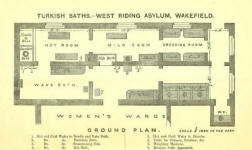
 In 1871, James (later Sir James) Crichton-Browne installed a Turkish bath at Wakefield Asylum. He was specially concerned about asylum hygiene and drainage, and so the Turkish bath also had a wide range of showers, baths, and steam cabinets.
In 1871, James (later Sir James) Crichton-Browne installed a Turkish bath at Wakefield Asylum. He was specially concerned about asylum hygiene and drainage, and so the Turkish bath also had a wide range of showers, baths, and steam cabinets.
The building work was undertaken by a group of patients who were extremely skilled artisans and who carried it out to an extremely high standard. On occasion some of the patients were unable to attend and this necessarily slowed completion of the building, but the delay was considered worthwhile because of the competence and elegance which could not otherwise have been obtained.1

The six room Turkish bathhouse had doorways ornamented with stone arches in the Moorish style, was lit by frosted glass windows, and was lined with encaustic tiles. The entrance to the baths, at the end of the building, led into a passageway with two doors on the right and a toilet at the end.
The first door opened into the Turkish baths 'dressing room', furnished with four relaxation couches. Next was the 'mild room' kept at 110° F, and then the 'hot room' which could be maintained at any temperature up to 190° F.
Unusually, the hot room could also, if required, be filled with steam and converted into a Russian bath. When this was done, bathers would also be able to use a needle shower, and a 'fountain bath' from which a 'stream of water' could be 'applied to the rectum or anus'. Both of these were on the far side of the room, close to the shampooing area in the next room. The hot and cold taps supplying them with water were within the shampooing room itself under the control of the shampooer. Apart from safety considerations, this would also ensure that they could not be turned on when the hot room was being used with dry air.
The shampooing table had its own basin and flexible water spray, while on the other side of the room there was a 'wave bath from which a broad sheet of cold water can be made to sweep over the body.'
The fifth room was a bathroom with slipper, sitz, and hip baths, together with a weighing machine. The last room, which was also accessible from the entrance corridor, housed three cabinet baths which could be used for steam or a variety of medicated vapour baths.
The baths were reported as being particularly useful in relieving melancholia and in treating skin diseases and rheumatism. Crichton-Browne's claim that 'there are no baths in this country…which are more complete or more pleasing in their general effect than those of the West Riding Asylum' seems to have been well justified.2